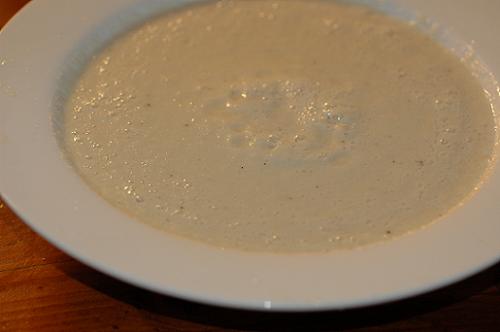Latkes or fried potato pancakes (Yiddish: לאַטקעס), have a special place in Jewish history. They originated in the Ashkenazi Jewish cuisine of Eastern Europe and spread from that source to the diaspora, but the roots of latke as a dish probably pre-date Jewish settlement in Poland. They are traditionally eaten during the Jewish winter festival of Hannukah. This dish celebrates my grandmother and great grandmother who escaped from Poland as refugees and settled in Britain. Ingredients (makes 10-12 latkes) 5 large potatoes (Maris Piper or similar variety)* 1 large onion 3 large eggs 75g white flour (gluten-free white flour works fine) (or matzo meal) pinch salt black pepper 5 cloves small piece of cinnamon 50g brown sugar 3 large cooking apples (Bramleys, Granny Smith or similar) 1 lemon 75ml soured cream vegetable oil vanilla extract * It's important to use "mealy" potatoes of the sort that produce dry mash. These are ones with relatively high solid mass to water ratio). Method |
 | In the old days in the poverty of Eastern Europe, latkes would have been made from the simplest of ingredients - potato, onion, flour and eggs with a little salt. Black pepper would probably have been a luxury addition to the dish. |
| Luckily, today we can enrich and enliven this dish without losing sight of the original basic fried potato pancake. The perfect accompaniments for latkes are apple sauce (made with cinnamon and cloves) and soured cream with a dash of vanilla. |  |
 | Although the onions and potatoes can be finely chopped and then pureed by hand, it is much easier these days to roughly chop the vegetables and use a food processor to create the mixture. If you can't use the potato immediately, keep in under water until used. Gently beat the eggs. |
| Chop the potatoes and onions in a processor and then transfer if necessary into a blender attachment and add the eggs, salt, freshly ground black pepper and the flour or matzo meal. One thing to note is that latke mix requires more salt than you might assume. |  |
 | Puree the mixture until you achieve a smooth mix with plenty of aeration. Test for sesasoning and add more if required. The latke mix now needs to be left to cool before use. It can be left overnight in the fridge, but a better way to prepare latkes in advance is to part-fry (not too much!), cool and store and then complete the frying as required. |
| Next for the apple sauce. Peel the apples and remove the cores and pips. A peeler such as the one shown is an ideal implement for gauging out the core. Insert tip down, concave side facing the core and rotate around until the core lifts clean out. |  |
 | Next, zest the lemon and put the zest to one side. Quarter the peeled apples and squeeze the lemon's juice over the pieces, being careful to avoid pips falling into the pan. Take about 1 tsp of the zest and add this to the pan. Finally, add most of the brown sugar. |
| Many people add their spices whole and remove them after cooking and before serving. Personally I like to grind the spices and leave them in the mixture when cooked. Either way, add the cinnamon and cloves. |  |
 | The best result comes from fruit reduced in its own liquid, but you may need to add a small amount of boiling water. Bring to the boil, cover the pan, reduce the heat and simmer for about 15 minutes. Check for sweetness and adjust with brown sugar. The sauce is best if not too sweet. |
| When cooked, the apple sauce will have a pleasant texture and a golden colour. Some people like to blend their sauce at this stage, but I prefer it textured. Chill the mixture thoroughly. You could serve the sauce hot, but for this recipe the best result is with hot latkes and chilled sauce and cream. |  |
 | To cook the latkes, heat a little oil into a frying pan and add a large spoonful of mix. Traditional recipes often use olive oil for the frying, but vegetable oil will allow a hotter frying temperature without smoking. It's best to start with one latke and make two or three together in subsequent batches. |
| Most important is that the mixture is allowed to spread so the latkes are relatively thin. Remember that the mixture ingredients are uncooked, so if the pancakes are thicker they will not cook properly in the centre. |  |
 | With a little practice you will be able to achieve a perfect brown colour with the centre soft but cooked, without too much oil being absorbed. It's still a good idea to turn them out onto absorbent paper, though, to soak up any excess oil. |
| Plate your latkes and add a good dollop of apple sauce. Add a drop or two of vanilla extract and top off with a tablespoon or two of soured cream. A grating of black pepper makes the perfect final touch, adding a hint of bitterness to the sweetness of the apple and sourness of the cream. Enjoy! Mazel Tov! |  |



